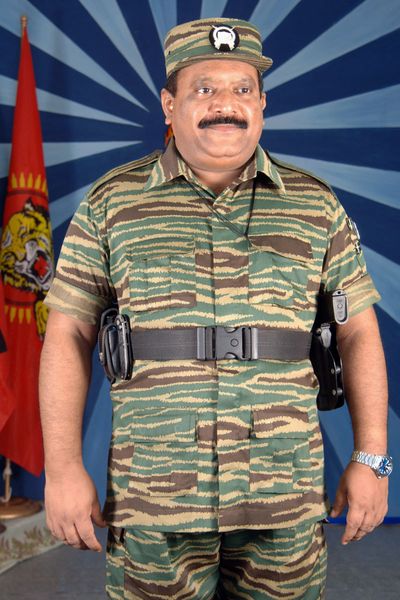Sri Lankan rebel leader ran ruthless movement
Tamil Tiger tactics, including suicide vests, became standard for militants

NEW DELHI – Reclusive Tamil Tiger chief Velupillai Prabhakaran had escaped death several times during the past three decades even as his obsession with security ensured that untold other assassins never got close.
But Monday, in northern Sri Lanka, the mustached 54-year-old leader’s time ran out. According to government reports, he was killed along with two top aides as they tried to escape in an ambulance during the final throes of fighting between the Sri Lankan military and the ethnic militant group. The Sri Lankan government quickly declared victory in its quarter-century war against the Tigers, who sought a homeland for marginalized Tamils in the Sinhalese-majority nation.
During his career as a rebel, Prabhakaran created a ruthless and sophisticated insurgency, with many of the tactics he pioneered becoming standard operating procedure for militant groups. Along the way, he refined the use of suicide bombings, offered tactical inspiration to al-Qaida and Hamas and ordered up the assassination of political leaders, including Indian Prime Minister Rajiv Gandhi.
As news of the legendary leader’s death spread over state television and in government text messages, civilians in the capital city of Colombo danced, sang and lit fireworks.
But some within the Tamil community, which accounts for around 12 percent of the island’s population of 20 million, were less enthused, wary that the sense of nationalist triumphalism could spark acts of vengeance against them. And some felt they lost their only defender against state brutality, as flawed as he was.
Started on street level
His group grew from little more than a street gang into one of the world’s most successful militant operations within a decade.
At its peak, it controlled one-third of Sri Lanka’s territory, had its own army and navy, a nascent air force, courts, tax collectors, hospitals, global smuggling operations and liaison offices in 54 countries. Its innovations included the use of suicide vests lined with C-4 explosives, recruiting female suicide bombers and targeting politicians.
Tigers naval operations reportedly inspired al-Qaida’s 2000 attack on the U.S. destroyer Cole. Until the U.S.-led invasion of Iraq in 2003, the Tigers, known formally as the Liberation Tigers of Tamil Eelam, reportedly carried out two-thirds of all suicide attacks worldwide.
For all his efforts, Prabhakaran’s obsessive focus and unwavering drive for an independent Tamil state might have left his people worse off than they were when he launched the Tigers in the 1970s.
“When you look at it from a historical standpoint, it was kind of pointless,” said Anita Pratap, author of “Island of Blood,” one of the few people to interview Prabhakaran. “There were so many lives lost, so many Tamils paid such a high price. It was such a tragic loss.”
Analysts said he was a brilliant military tactician. But even as other militant groups like the Irish Republican Army turned in their guns for a place at the negotiating table, his refusal to compromise ultimately left Tamils with little in the way of a lasting political legacy.
Discrimination, violence sparked radicalism
Prabhakaran, the youngest of four children, was born on Nov. 26, 1954, into a lower-caste family in Velvettithurai on the Jaffna peninsula. The son of a government clerk, he was remembered as shy, quiet and an unassuming high school dropout who loved Clint Eastwood films, Chinese food and books on military strategy.
He became politically aware during the 1960s and ’70s, emerging as one of thousands of radicalized Tamil youths in northern Sri Lanka because of violence and discrimination at the hands of the Sinhalese.
He launched the Tigers in 1972, putting himself squarely on the map in 1975 by gunning down the Tamil mayor of Jaffna, Alfred Duraiappah, for what he saw as cozying up to the Sri Lankan government. Prabhakaran explained later that he felt it was important to act rather than harbor illusions.
The military fight against the government began in 1983 when the Tigers launched a land mine attack that killed 13 soldiers. Over the next quarter-century, the group staged hundreds of attacks, killing civilians, army, government officials and even heads of state. Along the way, he purged many rivals in a conflict that has taken more than 70,000 lives.
‘Obviously paranoid’
From an early age, Prabhakaran was obsessed with secrecy – on leaving home at 18 he reportedly burned all family photos of himself – and maintained extensive safeguards as the organization grew.
“He was obviously paranoid about security,” said M.K. Narayan Swamy, author of the biography “Inside an Elusive Mind.” “And for justifiable reasons.”
Prabhakaran rarely slept in the same jungle hideout two nights in a row, employed a three-tiered bodyguard system, hired doubles and removed or killed those who displayed even a hint of disloyalty.
Considered a hero to some, Prabhakaran also has been dubbed a megalomaniac, a military genius and “lord of the jungle.” The Tigers earned a place on the U.S., European Union and Indian list of terror groups.
Prabhakaran had his share of close calls. In 1972, a bomb he and others were making exploded prematurely, injuring his leg. In 1987 he was close to being captured by the Sri Lankans, only to have Indian Prime Minister Indira Gandhi rescue him for political reasons.
Three years later, the Indians nearly captured him only to see then Sri Lankan Prime Minister Ranasinghe Premadasa help him as a way to kick Indian “peacekeepers” off the island. A few years later, he had Premadasa assassinated.
His biggest miscalculations, analysts said, were the Rajiv Gandhi assassination in 1991, failing to pursue peace talks after 2002 and calling on Tamils to boycott elections in 2005, leading to a narrow victory for President Mahinda Rajapaksa.
Rajapaksa proceeded to wage the successful military campaign that culminated in bringing down the Tigers.